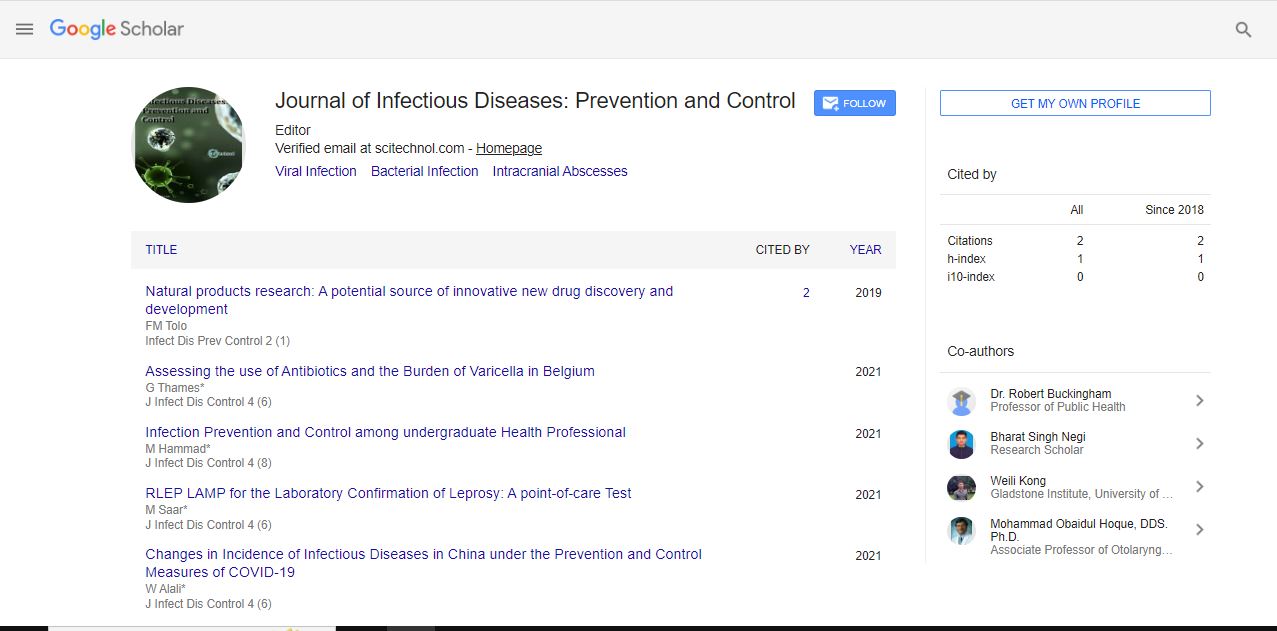Perspective, Vol: 6 Issue: 2
Current Trends and Future Prospects of Antiviral Therapeutics
Avinash Sharma*
1 Department of Infectious Diseases, Meenakshi Mission Hospital & Research Centre, Madurai, India
*Corresponding Author: Avinash Sharma,
Department of Infectious Diseases,
Meenakshi Mission Hospital & Research Centre, Madurai, India
E-mail: avinash65756@gmail.com
Received date: 27 May, 2023, Manuscript No. IDPC-23-105456;
Editor assigned date: 29 May, 2023, Pre QC No. IDPC -23-105456 (PQ);
Reviewed date: 15 June, 2023, QC No. IDPC -23-105456;
Revised date: 23 June, 2023, Manuscript No. IDPC -23-105456 (R);
Published date: 30 June, 2023, DOI: 10.36648/idpc.5.2.134
Citation: Sharma A (2023) Current Trends and Future Prospects of Antiviral Therapeutics. Infect Dis Prev Control 6:2.
Abstract
Antiviral medications have revolutionized the field of medicine by providing effective treatment options against a wide range of viral infections. This article explores the development, mechanism of action, and clinical applications of antiviral drugs. It also highlights their limitations, challenges, and future prospects in combating viral diseases. Understanding the role of antivirals is crucial in the ongoing battle against viral pathogens and in improving global public health.
Description
Antiviral medications have revolutionized the field of medicine by providing effective treatment options against a wide range of viral infections. This article explores the development, mechanism of action, and clinical applications of antiviral drugs. It also highlights their limitations, challenges, and future prospects in combating viral diseases. Understanding the role of antivirals is crucial in the ongoing battle against viral pathogens and in improving global public health.
Antiviral drugs employ various mechanisms to target viral replication and propagation. It discusses the various antiviral drugs' ways of action, including inhibition of viral enzymes, disruption of viral replication cycles, interference with viral entry into host cells, and modulation of host immune responses. Examples of specific antiviral drugs and their mechanisms of action are discussed. The clinical applications of antiviral drugs span a wide range of viral infections.
As a response to emergency situations, researchers are investigating the repurposing of existing drugs designed for other purposes. This approach accelerates drug development and utilizes the safety and efficacy data of these drugs, potentially offering a quicker solution during outbreaks. Nano medicine is the new approach for antiviral drug delivery. Nanoparticles can be engineered to specifically target infected cells, ensuring efficient drug delivery while reducing adverse effects on healthy tissues. This process helps to enhance the therapeutic index of antiviral medications. Gene editing technologies, notably CRISPR-Cas9, has sparked excitement in the realm of antiviral therapeutics. These tools offer the potential to directly edit viral genomes, rendering them non-functional. Although this concept is still in its starting stage gene editing could eventually lead to curative treatments for certain viral infections.
Enhancing the body's innate immune response against viruses is helpful to fight against viral infections. Immunomodulatory drugs could bolster the immune system's ability to identify and neutralize viral invaders, offering a potential therapy against a wide array of viral infections. Antiviral vaccines have historically been transformative in preventing viral infections. The recent advancements in mRNA vaccine technology is uesd in the rapid development of COVID-19 vaccines and the potential for swift vaccine responses during outbreaks. Furthermore, on-going research aims to create universal vaccines that confer protection against multiple viral strains. Artificial intelligence and data analytics have found their way into antiviral drug discovery. Machine learning algorithms can predict potential antiviral compounds; analyze viral mutations, and model viral behaviour. These technologies have the potential to identification of effective antiviral medications.
Antiviral medications have revolutionized the fight against viral infections, providing effective treatment options for various viral illnesses. Improvement in this field are important to combat viral diseases, improve patient outcomes, and safeguard global public health. Antiviral drugs have had a profound impact on the management of viral infections. However, continued research and development are necessary to overcome the challenges associated with viral resistance, drug toxicity, and limited spectrum efficacy. By harnessing innovative approaches and fostering collaboration, the field of antiviral therapeutics can continue to make significant strides in combating viral pathogens and protecting human health.
 Spanish
Spanish  Chinese
Chinese  Russian
Russian  German
German  French
French  Japanese
Japanese  Portuguese
Portuguese  Hindi
Hindi 